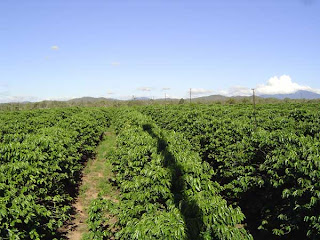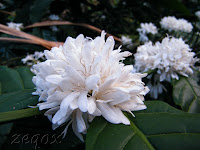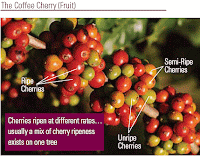Coffea, a member of the Rubiaceae family is responsible for the biological heritage of “coffee.” The Rubiaceae family includes more than 500 genera and 6,000 species of tropical trees and shrubs.
It is doubtful the average person would recognize an actual coffee tree. Most of us would recognize a roasted coffee bean. Just in case you stumble upon something you think might be a real coffee tree, here is a quick description of one:
Descriptions of a Coffee Tree
- Pruned short in cultivation
- Capable of growing more than 30 feet high
- Generally covered with dark-green, waxy leaves that grow opposite each other in pairs, although a coffee tree can also have leaves that are purple or yellow (dark green is the predominant color) The leaves may be 1 to 40 centimeters in size (.39 to 15.74 inches)
- Coffee cherries grow along the tree’s branches (see below for a description of coffee cherries)
- Coffee cherries bloom into flowering, fragrant, white blossoms after about a year
- Because coffee cherries grow in a continuous cycle you might see flowers, green fruit and ripe fruit at the same time on a single tree
A coffee tree can live as long as 20 to 30 years. They are capable of growing in a wide range of climates so long as the climate does not have harsh fluctuations in temperature. Coffee trees grow best in a rich soil and mild temperature with frequent rain and shaded sun. Heavy frost will kill coffee trees.
Commercial Coffee Species
It is estimated that there are 25 to 100 species of coffee plants. In the commercial coffee industry, there are two important coffee species. These are:
- Arabica
- Canephora (more commonly called robusta)
Varieties of Coffea Arabica – C. Arabica include:
- Bourbon
- Typica
- Caturra
- Mundo
- Novo
- Tico
- San Ramon
- Jamaican Blue Mountain
The original coffee trees were discovered in Ethiopia. Coffea Arabica comes from these original coffee trees. The coffee trees in Ethiopia produce a fine, mild, aromatic coffee. Over half of the world’s coffee production originates from the coffee trees in Ethiopia. Arabica coffees bring the highest prices in the world market of coffee. Better arabicas are high grown coffees, generally between 2,000 to 6,000 feet above sea level.
The Arabica coffee trees are costly to cultivate due to the following factors:
- The terrain tends to be steep and access is difficult
- The Arabica coffee trees are more disease prone than robusta coffee trees, which requires additional care and attention
Variety of Coffea canephora – C. canephora var. robusta include:
- Robusta
Most robusta coffee trees are grown in Central and Western Africa, parts of Southeast Asia, which includes Indonesia and Vietnam. Brazil is also a country in which the robusta coffee tree is grown, however, Brazil accounts for only about 30 percent of the world market.
Characteristics of the Coffee Cherry
What does a “coffee cherry” look like? You will recognize a “coffee cherry” by the following characteristics:
Source: The National Coffee Association- The outer skin of a coffee cherry is called the “exocarp”
- Beneath the exocarp is the “mesocarp,” which is a thin layer of pulp
- This thin layer of pulp is followed by a slimy layer called the “parenchyma”
- The beans themselves are covered in a parchment-like envelope called the “endocarp” and more commonly called “the parchment”
- Inside the parchment, side-by side lie two beans
- Each of these beans are covered separately by another layer of thin membrane or seed skin called “spermoderm”
- The spermoderm is generally referred to in the coffee trade as the “silver skin.”
I thank you for stopping by Coffee Beans and Machines and taking your time to read my post "The Anatomy Of A Coffee Tree.". Hope that you found the article informative. Feel free to comment or share. Being new at this I need all the help that I can get. Below I have my most recently published post, Pages, and my other free blogs from google.
Thanks again and y'all come back now.
Keep Smiling
reuben
My Recently Published Post
The Great Coffee Beverage - Some History And What Really Goes Into It.
The History Of Maxwell House Decaf Coffee
The History Of Coffee Houses
The History Of Coffee
Coffee the Beverage That History Loves
The History Of Maxwell House Decaf Coffee
The History Of Coffee Houses
The History Of Coffee
Coffee the Beverage That History Loves
My Pages
Coffee (ground coffee)
Beans (whole coffee beans)
Machines
Sitemap
eCoffee (ground coffee)
eBeans (whole coffee beans)
eMachines
(eStores are powered by Amazon)
My Blogs
Reubens Lawn Care (will take you to the sitemap)
Going Green with Reuben
Coffee Beans and Machines
Related articles
- Difference between Coffee Arabica and Robusta (expertscolumn.com)
- Restaurant of the Week - Bean Tree Coffee (kdvr.com)
- 2013 04 07 - Coffee (johnsgarden.wordpress.com)
- Arabica Vs. Robusta - Whats the difference? (jonnysjava.wordpress.com)
- Exploring Coffee's Past To Rescue Its Future (wnyc.org)
- Hawaii island hotel plants Kona coffee trees (staradvertiser.com)
- Puerto Rico faces lowest coffee production ever (jsonline.com)
- Coffee Facts That Surprise (foxnews.com)




No comments:
Post a Comment